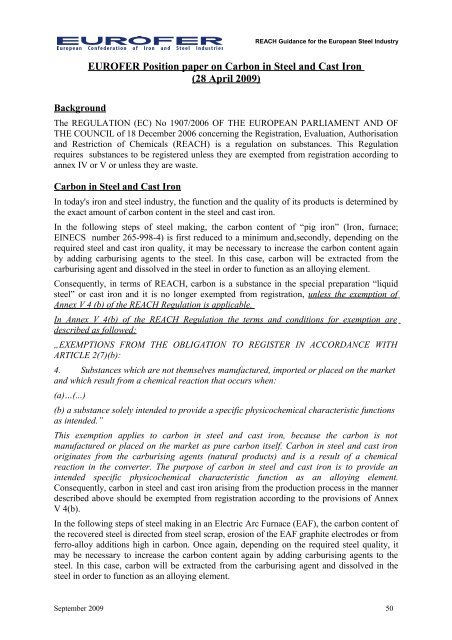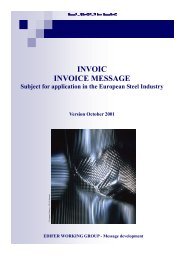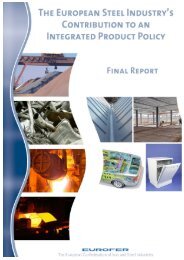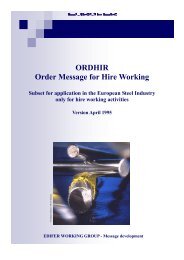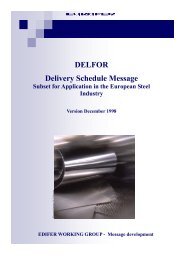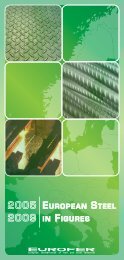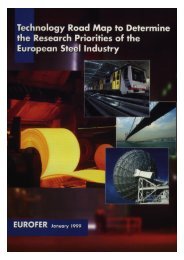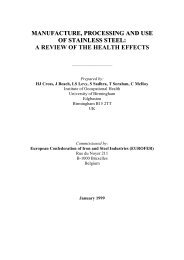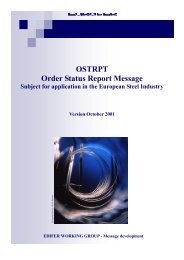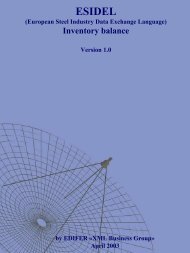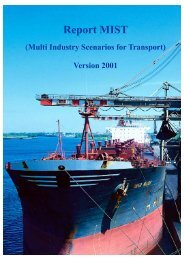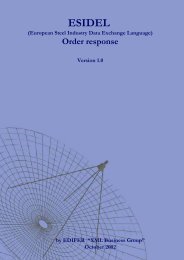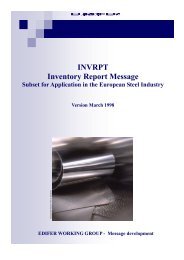EUROFER REACH guidance for the European Steel Industry. 09.09 ...
EUROFER REACH guidance for the European Steel Industry. 09.09 ...
EUROFER REACH guidance for the European Steel Industry. 09.09 ...
You also want an ePaper? Increase the reach of your titles
YUMPU automatically turns print PDFs into web optimized ePapers that Google loves.
Background<br />
<strong>REACH</strong> Guidance <strong>for</strong> <strong>the</strong> <strong>European</strong> <strong>Steel</strong> <strong>Industry</strong><br />
<strong>EUROFER</strong> Position paper on Carbon in <strong>Steel</strong> and Cast Iron<br />
(28 April 2009)<br />
The REGULATION (EC) No 1907/2006 OF THE EUROPEAN PARLIAMENT AND OF<br />
THE COUNCIL of 18 December 2006 concerning <strong>the</strong> Registration, Evaluation, Authorisation<br />
and Restriction of Chemicals (<strong>REACH</strong>) is a regulation on substances. This Regulation<br />
requires substances to be registered unless <strong>the</strong>y are exempted from registration according to<br />
annex IV or V or unless <strong>the</strong>y are waste.<br />
Carbon in <strong>Steel</strong> and Cast Iron<br />
In today's iron and steel industry, <strong>the</strong> function and <strong>the</strong> quality of its products is determined by<br />
<strong>the</strong> exact amount of carbon content in <strong>the</strong> steel and cast iron.<br />
In <strong>the</strong> following steps of steel making, <strong>the</strong> carbon content of “pig iron” (Iron, furnace;<br />
EINECS number 265-998-4) is first reduced to a minimum and,secondly, depending on <strong>the</strong><br />
required steel and cast iron quality, it may be necessary to increase <strong>the</strong> carbon content again<br />
by adding carburising agents to <strong>the</strong> steel. In this case, carbon will be extracted from <strong>the</strong><br />
carburising agent and dissolved in <strong>the</strong> steel in order to function as an alloying element.<br />
Consequently, in terms of <strong>REACH</strong>, carbon is a substance in <strong>the</strong> special preparation “liquid<br />
steel” or cast iron and it is no longer exempted from registration, unless <strong>the</strong> exemption of<br />
Annex V 4 (b) of <strong>the</strong> <strong>REACH</strong> Regulation is applicable.<br />
In Annex V 4(b) of <strong>the</strong> <strong>REACH</strong> Regulation <strong>the</strong> terms and conditions <strong>for</strong> exemption are<br />
described as followed:<br />
„EXEMPTIONS FROM THE OBLIGATION TO REGISTER IN ACCORDANCE WITH<br />
ARTICLE 2(7)(b):<br />
4. Substances which are not <strong>the</strong>mselves manufactured, imported or placed on <strong>the</strong> market<br />
and which result from a chemical reaction that occurs when:<br />
(a)…(...)<br />
(b) a substance solely intended to provide a specific physicochemical characteristic functions<br />
as intended.”<br />
This exemption applies to carbon in steel and cast iron, because <strong>the</strong> carbon is not<br />
manufactured or placed on <strong>the</strong> market as pure carbon itself. Carbon in steel and cast iron<br />
originates from <strong>the</strong> carburising agents (natural products) and is a result of a chemical<br />
reaction in <strong>the</strong> converter. The purpose of carbon in steel and cast iron is to provide an<br />
intended specific physicochemical characteristic function as an alloying element.<br />
Consequently, carbon in steel and cast iron arising from <strong>the</strong> production process in <strong>the</strong> manner<br />
described above should be exempted from registration according to <strong>the</strong> provisions of Annex<br />
V 4(b).<br />
In <strong>the</strong> following steps of steel making in an Electric Arc Furnace (EAF), <strong>the</strong> carbon content of<br />
<strong>the</strong> recovered steel is directed from steel scrap, erosion of <strong>the</strong> EAF graphite electrodes or from<br />
ferro-alloy additions high in carbon. Once again, depending on <strong>the</strong> required steel quality, it<br />
may be necessary to increase <strong>the</strong> carbon content again by adding carburising agents to <strong>the</strong><br />
steel. In this case, carbon will be extracted from <strong>the</strong> carburising agent and dissolved in <strong>the</strong><br />
steel in order to function as an alloying element.<br />
September 2009 50


